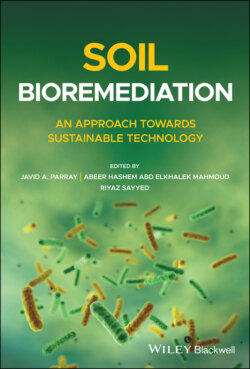Читать книгу Soil Bioremediation - Группа авторов - Страница 29
2.4 Fate of Pesticides and Its Biodegradation in Soil
ОглавлениеOrganophosphate pesticide primarily catalyzes the degradation of the neurotransmitter acetylcholine in the synapse. This enzyme rapidly hydrolyzes the acetylcholine, a neurotransmitter into choline by stopping the stimulation of nerves. These compounds block the normal activity of acetylcholinesterase by binding covalently to the enzyme, thereby changing the activity and function. The accumulation of neurotransmitter acetylcholine (Ach) in the synapse leads to blockage of nerves because regeneration of acetylcholine esterase is a slow process and takes hours or even days. This blockage of nerves causes permanent paralysis and finally the death of insects and pests. Solanum lycopersicum L. being the important human diet constituent is grown throughout the world. It is commonly used in a salad, consumed as a sauce and juice. Different types of pesticides like cypermethrin, deltamethrin, profenofos, and chlorpyriphos, are used to protect the tomato crop from damage caused by these insects and pests [87].
Bioaccumulation is the primary cause of toxicity of pesticides as their higher concentrations in biological systems leads to major health problems. The persistence of organophosphate pesticides in soil has also been related to the organic matter, clay content, and iron or aluminum oxy content of the soil. These have a higher affinity to absorbing the pesticides and act as a sink for such hydrophobic compounds affecting plants, humans, and animals. Pesticides undergo various changes in the environment comprising their adsorption transmission and degradation, which depends on the nature of soil, pesticide type, and its physico‐chemical properties. The predominant process involved in transformation of such molecules is facilitated by microbes [78] followed by photolysis or photo‐degradation and chemical transformations [43]. Chemical and microbial degradation are difficult to distinguish as both processes go side by side. Further the physical properties of the soil also play an integral part, as the clay content in soil leads to an increase in surface area, which enhances hydrolytic conversion [55].
Bioremediation is considered an environment friendly, green, and economical technology for degradation of persistent organic pollutants such as pesticides. Pseudomonas putida, Bacillus subtilis, Burkholderia gladioli, and Pseudomonas aeruginosa have been reported as efficient microbial species for the degradation of profenofos pesticide. These microbial species degrade profenofos by hydrolysis to yield 4‐bromo‐2‐chlorophenol as metabolite [73]. Hydrolysis being the most significant step plays an important role in detoxifying the organophosphate compound that makes it vulnerable to further degradation. Esterase or phosphortriesterase enzymes are responsible for this reaction. Numerous microorganisms can hydrolyze the organophosphate pesticide. Illustrations include Pseudomonas diminuta MG and Flavobacterium ATCC 27551 possessing the organophosphate hydrolase enzyme [51]. Bacterial strains isolated from pesticide‐contaminated soil and these strains were tested for their degradation capability and it was found that JCp4 and FCp1 degraded 84.4 and 78.6% the chlorpyrifos pesticide respectively. Moreover, these strains also showed plant growth promoting traits, which includes phytohormone production, phosphate solubilization, and N2 fixation, etc. [49]. In Pakistan, pesticide residues were found above permissible limits in different vegetables analyzed for pesticide residues. It was found that all samples contained pesticide residues of carbofuran and chlorpyrifos and limits with concentrations ranging from 0.01–0.39 and 0.05–0.96 mg/kg, respectively were observed [81].
